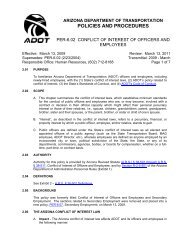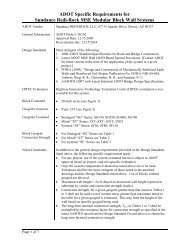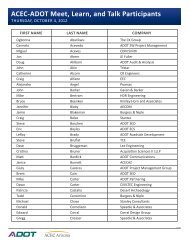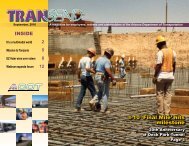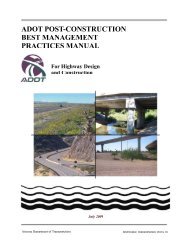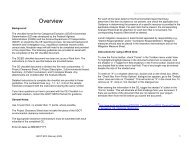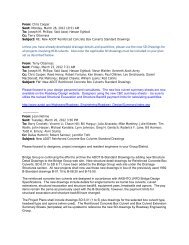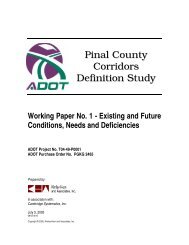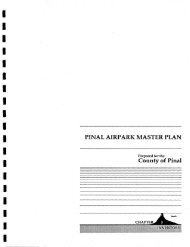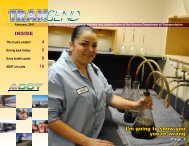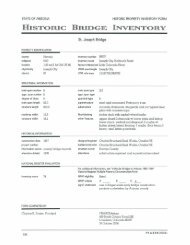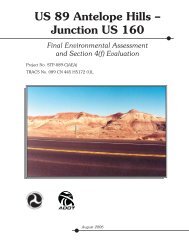I-10 Twin Peaks Traffic Interchange, Environmental Assessment
I-10 Twin Peaks Traffic Interchange, Environmental Assessment
I-10 Twin Peaks Traffic Interchange, Environmental Assessment
You also want an ePaper? Increase the reach of your titles
YUMPU automatically turns print PDFs into web optimized ePapers that Google loves.
Affected Environment and <strong>Environmental</strong> Impacts October 2005<br />
area, playground, restrooms, and drinking water on 500 acres. LWCFA funds were<br />
used in 1980 to build a softball field and again in 1983 for ball field lighting;<br />
therefore, this facility is protected under Section 6 (f) of the LWCFA.<br />
Impacts<br />
No Build Alternative<br />
The no build alternative would not acquire recreational properties funded with<br />
LWCFA funds; therefore the no build alternative would have no impacts to<br />
Section 6 (f) facilities. The no build alternative would not improve access to or<br />
connectivity between recreational facilities or provide increased availability of<br />
bicycle or pedestrian facilities.<br />
Preferred Alternative<br />
The preferred alternative would not acquire recreational properties funded with<br />
LWCFA funds; therefore the preferred alternative would have no impacts to<br />
Section 6 (f) facilities. The preferred alternative would improve regional access to<br />
the recreational facilities.<br />
Mitigation<br />
No mitigation is required because no effects to Section 6 (f) facilities would result<br />
from the preferred alternative.<br />
Conclusion<br />
The preferred alternative would have no impacts to Section 6 (f) facilities, but<br />
would improve access to and connectivity between recreational facilities.<br />
Section 4(f) Department of Transportation Act<br />
Section 4(f) of the U.S. Department of Transportation Act of 1966 states that the<br />
FHWA “may approve a transportation program or project requiring publiclyowned<br />
land of a public park, recreation area, or wildlife and waterfowl refuge of<br />
national, state, or local significance, or land of a historic site of national, state, or<br />
local significance (as determined by the federal, state, or local officials having<br />
jurisdiction over the park, area, refuge, or site) only if there is no prudent or<br />
feasible alternative to using that land and the program or project includes all<br />
possible planning to minimize harm to the park, recreation area, wildlife and<br />
waterfowl refuge, or historic site resulting from the use” (49 U.S.C. 303).<br />
A use of a Section 4(f) resource, as defined in 23 CFR 771.135 (p), occurs: when<br />
land is permanently incorporated into a transportation facility; when there is a<br />
temporary occupancy of land that is adverse in terms of the statute’s<br />
preservationist purposes, and/or; when there is a constructive use of land. A<br />
constructive use of a Section 4(f) resource occurs when the transportation project<br />
does not incorporate land from the Section 4(f) resource, but the project’s<br />
Interstate <strong>10</strong> <strong>Traffic</strong> <strong>Interchange</strong> at<br />
<strong>Twin</strong> <strong>Peaks</strong>/Linda Vista<br />
4-89<br />
Project No.: NH-0<strong>10</strong>-D (AIW)<br />
TRACS No.: <strong>10</strong> PM 236 H5838 01D



